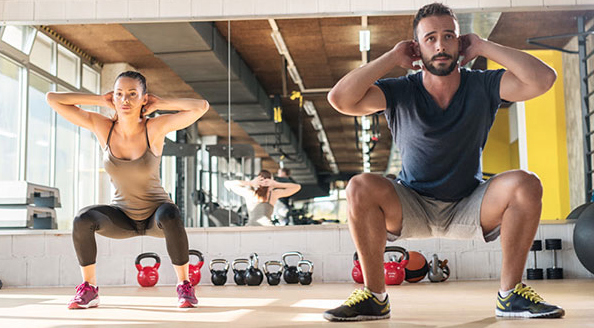All about squats – classic technique and 22 types of squats, program for beginners

In most sports disciplines, the functional development of the legs is the key to the effectiveness of the athlete. Squats are considered the best exercise for training the lower extremities. The element involves several joints and large muscles in the work: quadriceps and gluteus maximus. Due to this, the athlete increases speed and strength.
Squats improve body balance by developing stabilizing muscles:
leading;
calf;
soleus;
hamstrings;
abdominal;
back extensors.
The positive impact of squats
The main advantage of the exercise is a complex effect. An athlete who uses squats in training develops not only muscles, but also improves the functioning of the body:
Strengthening the heart . High-speed multi-rep squats without additional weights are equivalent in efficiency to full-fledged cardio loads – the main training of the heart muscle and increasing endurance.
Mass set . We are talking about exercises with power shells. Squats with a barbell on the shoulders give a powerful impetus to the production of growth hormones, which makes the element basic in the training program of bodybuilders and powerlifters.
Strengthening the male reproductive system . Athletes who regularly squat with a barbell or other weights improve blood circulation in the pelvic organs, which helps to improve the genitourinary system and restore libido.
Lower body workout for women . Most gym goers dream of toned hips and round buttocks. Squats help to accentuate these muscle groups, get rid of flabbiness.
Slimming . The reduction in subcutaneous fat depends on the energy intensity of the exercises. Squats force large muscles to consume a large number of calories, which means getting rid of extra pounds and cellulite.
The exercise is used to recover from sprains and injuries. Light half-range squats without additional weight will help strengthen joint tissues and tendons, and restore mobility to the athlete.
classical technique
There is a basic squat technique that is common to most of these exercises. It should be carefully disassembled before starting classes:
We place the feet shoulder width apart, parallel to each other.
Body weight is distributed over the entire surface of the feet.
Hands are freely lowered to the sides.
Keep your head straight and look straight ahead.
We tighten the stomach, inhale, gently lower the pelvis.
At the same time, we bring our hands in front of us to the horizontal.
We do not linger at the lower point – we exhale, we return to the vertical position.
Having learned how to squat correctly in the classical technique, try to shift the emphasis of the load. This will help to qualitatively work out individual muscle groups.